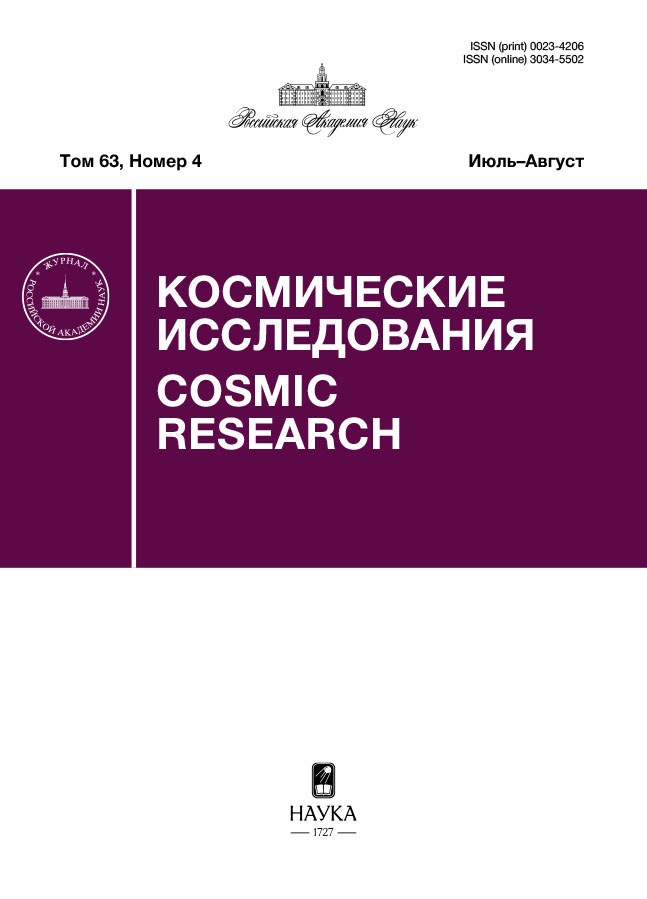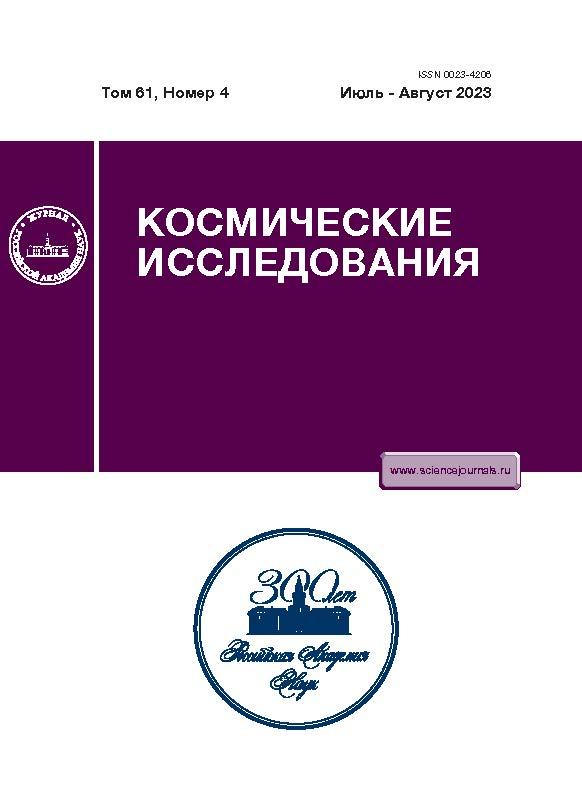A Study of the Motion of Four Linked Satellites Controlled Using Lorentz Forces
- Authors: Chernov K.S.1, Ivanov D.S.1
-
Affiliations:
- Keldysh Institute of Applied Mathematics, Russian Academy of Sciences, Moscow, Russia
- Issue: Vol 61, No 4 (2023)
- Pages: 339-352
- Section: Articles
- URL: https://rjsocmed.com/0023-4206/article/view/672640
- DOI: https://doi.org/10.31857/S0023420623600022
- EDN: https://elibrary.ru/UMATAE
- ID: 672640
Cite item
Abstract
This paper considers four satellites connected to each other by electrodynamic tethers, which are assumed to be rigid in the mathematical model of the system’s motion. In the Earth’s magnetic field, current-carrying conductors are affected by Lorentz forces, which are used to control the motion of the system’s center of mass and the angular motion. The paper presents an algorithm for calculating the magnitude of the current to stop the drift of the center of mass of a tetrahedral formation relative to the desired orbital reference frame in low Earth orbit and spin the system up to a constant angular velocity relative to the center of mass. A numerical study of the convergence time to achieve the required motion is carried out depending on the maximum possible current and initial conditions.
About the authors
K. S. Chernov
Keldysh Institute of Applied Mathematics, Russian Academy of Sciences, Moscow, Russia
Email: chernow.kirill@gmail.com
Россия, Москва
D. S. Ivanov
Keldysh Institute of Applied Mathematics, Russian Academy of Sciences, Moscow, Russia
Author for correspondence.
Email: chernow.kirill@gmail.com
Россия, Москва
References
- Shirobokov M.G., Trofimov S.P. Adaptive Neural Formation-Keeping Control for Satellites in a Low-Earth Orbit // Cosmic Research. 2021. V. 59. Iss. 6. P. 501–516. https://doi.org/10.1134/S0010952521060113
- Leonard C.L. Formationkeeping of Spacecraft via Differential Drag. Master Thesis. Massachusetts Inst. Technol., 1986. http://hdl.handle.net/1721.1/13358
- Mashtakov Y., Ovchinnikov M., Petrova T. et al. Two-satellite formation flying control by cell-structured solar sail // Acta Astronaut. 2020. V. 170. P. 592–600. https://doi.org/10.1016/j.actaastro.2020.02.024
- Ivanov D., Gondar R., Monakhova U. et al. Electromagnetic uncoordinated control of a ChipSats swarm using magnetorquers // Acta Astronaut. 2022. V. 192. P. 15–29. https://doi.org/10.1016/j.actaastro.2021.12.014
- Shestakov S., Ivanov D., Ovchinnikov M. Formation-Flying Momentum Exchange Control by Separate Mass // J. Guid. Control. Dyn. 2015. V. 38. Iss. 8. P. 1–10. https://doi.org/10.2514/1.G001137
- Peck M.A., Streetman B., Saaj C.M., Lappas V. Spacecrat Formation Flying Using Lorentz Forces // J. Br. Interplanet. Soc. 2007. V. 60. Iss. 7. P. 263–267.
- Peck M.A. Prospects and challenges for Lorentz-augmented orbits // Collect. Tech. Papers – AIAA Guid. Navig. Control Conf. 2005. V. 3. P. 1631–1646. https://doi.org/10.2514/6.2005-5995
- Schaffer L., Burns J.A. Charged dust in planetary magnetospheres: Hamiltonian dynamics and numerical simulations for highly charged grains // J. Geophys. Res. SP. Phys. 1994. V. 99. Iss. A9. P. 17211–17223.https://doi.org/10.1029/94JA01231
- Saaj C.M., Lappas V., Richie D. et al. Electrostatic forces for satellite swarm navigation and reconfiguration. Final report for Ariadna Study Id. AO 4919 05. ESA, 2006. 96 p.
- Liu J., Gangqiang L., Zhu Z.H. et al. Automatic orbital maneuver for mega-constellations maintenance with electrodynamic tethers // Aerospace Science and Technology. 2020. V. 105. Art. ID. 105910. https://doi.org/10.1016/j.ast.2020.105910
- Yang Y.-W., Cai H. Extended time–delay autosynchronization method for libration control of electrodynamic tether using Lorentz force // Acta Astronaut. 2019. V. 159. P. 179–188. https://doi.org/10.1016/j.actaastro.2019.03.038
- Lu H., Li A., Wang C., Zabolotnov Y. Stability analysis and motion control of spinning electrodynamic tether system during transition into spin // Acta Astronaut. 2020. V. 177. 2019. P. 871–881. https://doi.org/10.1016/j.actaastro.2019.11.032
- Voevodin P.S., Zabolotnov Y.M. Analysis of the Dynamics and Choice of Parameters of an Electrodynamic Space Tether System in the Thrust Generation Mode // Cosm. Res. 2020. V. 58. Iss. 1. P. 42–52. https://doi.org/10.1134/S0010952520010062
- Ohkawa Y., Kawamoto S., Okumura T. et al. Review of KITE – Electrodynamic tether experiment on the H-II Transfer Vehicle // Acta Astronaut. 2020. V. 177. 2019. P. 750–758. https://doi.org/10.1016/j.actaastro.2020.03.014
- Kalenova V.I., Morozov V.M. Stabilization of Satellite Relative Equilibrium Using Magnetic and Lorentzian Moments // Cosm. Res. 2021. V. 59. Iss. 5. P. 343–356. https://doi.org/10.1134/S0010952521050051
- Alexandrov A.Y., Tikhonov A.A. Electrodynamic Control with Distributed Delay for AES Stabilization in an Equatorial Orbit // Cosm. Res. 2022. V. 60. Iss. 5. P. 366–374. https://doi.org/10.1134/S0010952522040013
- Kalenova V.I., Morozov V.M. Novel approach to attitude stabilization of satellite using geomagnetic Lorentz forces // Aerospace Science and Technology. 2020. V. 106. Iss. 1. Art. ID. 106105. https://doi.org/10.1016/j.ast.2020.106105
- Guzmán J.J., Edery A. Mission design for the MMS tetrahedron formation // IEEE Aerosp. Conf. Proc. 2004. V. 1. P. 533–540. https://doi.org/10.1109/AERO.2004.1367637
- Shestakov S., Ovchinnikov M., Mashtakov Y. Analytical approach to construction of tetrahedral satellite formation // J. Guid. Control. Dyn. 2019. V. 42. Iss. 12. P. 2600–2614. https://doi.org/10.2514/1.G003913
- Guerman A.D., Smirnov G.V., Paglione P., Seabra A.M.V. Stationary configurations of a tetrahedral tethered satellite formation // J. Guid. Control. Dyn. 2008. V. 31. Iss. 2. P. 424–428. https://doi.org/10.2514/1.31979
- Hill G.W. Researches in the Lunar Theory // Am. J. Math. 1878. V. 1. P. 5–26.
- Ivanov D., Monakhova U., Ovchinnikov M. Nanosatellites swarm deployment using decentralized differential drag-based control with communicational constraints // Acta Astronaut. 2019. V. 159. P. 646–657. https://doi.org/10.1016/j.actaastro.2019.02.006
- Mashtakov Y.V., Ovchinnikov M.Y., Tkachev S.S. Study of the disturbances effect on small satellite route tracking accuracy // Acta Astronaut. 2016. V. 129. P. 22–31. https://doi.org/10.1016/j.actaastro.2016.08.028
- Барбашин Е.А. Введение в теорию устойчивости. М.: Наука, 1967.
- Кюнци Г.П., Крелле В. Нелинейное программирование. М.: Советское радио, 1965.
Supplementary files























